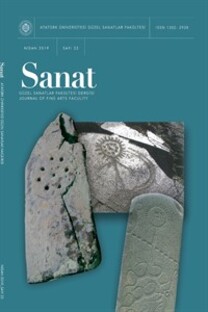Van ve Çevresindeki Hiristiyanlık Dönemi Yapılan Plan Açısından Değerlendirilmesi
Evaluation of the Churches in and Around Van in Terms of Plan
With a historical background dating back to the pre-writing ages, the city of Van and its vicinity came under the reign of the Byzantines as of the 5th century A.D. The region maintained its existence under the Byzantines and Sasanis by turns. After the late 7th century, the region was exposed to a long-term Armenian reign up until the late 10th century. Afterwards, this region came under the reign of the Byzantines again, terminating the 113-year-old Vaspurakan Armenian kingdom there. In and around the city of Van, where a lot of churches and monasteries were built, both Byzantium and Armenia were hosted. An examination of these buildings shows that they were built with circular and cross-shaped plans. The group of circular plan consists of the trikonkhos plan scheme having two different types, tetra and trikonkhos. The group of the cross-shaped plan, however, contains the types defined as open and closed Greek crosses as well as very large buildings with single nef and extending toward four directions via narrow corridors. Armenian art developed a peculiar style especially in field of architecture. Today there are many Armenian buildings, some in the East Anatolia Region, which were generally built in between the 5th and 7th centuries. Mixing their local traditions with those of the civilizations around them, they developed the regional Christian Art, also called as Armenian and Georgian
___
A.Grabar, Martyium, recherches sur le culte des relique et l'art Chretien antique, I Architecture, Paris 1946, s.369A.Jaubert, Voyage en Armenie, 1821, s.138 yd. M.Canard, Histoire de la Dynastie des H'amdanides de Jazire et de Syrie, I, Paris 1954, s.441-485
A.Khatchatrian, " L'architecture ermenienne Essai analytique", Vostan, 1(1948-49),s.7
A.Mansel, Side, Ankara 1998
A.Ulucam, Ortacag ve Sonrasinda Van G6IQ Cevresl MImarligi I Van, Ankara 2000, s. 10-13
C.Ceccheli, "sguardo generale all'architettura bizantina in italia", Studi bizantini e neoallenid, 1V( 1935), s.28
D. Kuban, Caglar Boyunca Turidye Sanatirun Anahatiari, istanbul, 2004, s.79-80
E.Swift, Roman Source of Christian Art, New York 1951, Lev. 16
G.Ogun; " Ortacag Boyunca Van Bolgesi Tarihi", SBD,I(1990), s.102-132
G.Oney; Akdamar Kilisesi, Ankara 1989, s.3; M.S. ipsiroglu, Ahtamar Killsesl, istanbul 1997, s.5
H.Brockhaus, Die Kunstinder Athos Kldstem, Leipzig 1924
J.Ebersolt, Le Grand palals de Constantinople, Paris 1910, s.l 10
J.M.Thierry, Armenian Art", New York 1989; s.497, f.635
J.M.Thierry; " Monasteres Armeniens du Vaspufakan", REA, Xl(1974), s.377
J.W.Crowfoot, Early Churches In Palestine, London 1941
K.Erdmann, Das lranische Feuerheillgtum, Leipzig 1941, s.59
N.Brunov, " Die Panagiakirche auf der Insel chalki in der umgebung von Konstantinopel", Byzantinisch Neugrlechische Jahrbucher, 1927-1928, s.509
S.Eyice, Karadag ve Cevresl, istanbul 1971, R.107
S.Der Nersessian, Aghtamar Church of the Holy Cross, Cambridge 1965, s.14
S.Eyice, L'eglise cruciforme de Side en Pamphylie et son importance au point de vue de I'histoire de l'art byzantin", Anatolia, 111(1958), s.35-42
S.Eyice, Son Devlr Bizans Mimarisi, istanbul 1980, s. 114-117
W.Bachmann, Kitchen und Mosehen In Armenien und Kurdistan, Leipzig 1913, s.28; Thierry, "Monasteres", VII, s. 162
- ISSN: 1302-2938
- Yayın Aralığı: Yılda 2 Sayı
- Başlangıç: 1999
- Yayıncı: Cordus
